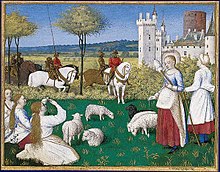
Quick Facts

Biography
Margaret, known as Margaret of Antioch in the West, and as Saint Marina the Great Martyr (Greek: Ἁγία Μαρίνα, Hagía Marína) in the East, is celebrated as a saint by the Roman Catholic and Anglican Churches on July 20 and on July 17 in the Orthodox Church. Her historical existence has been questioned. She was declared apocryphal by Pope Gelasius I in 494, but devotion to her revived in the West with the Crusades. She was reputed to have promised very powerful indulgences to those who wrote or read her life, or invoked her intercessions; these no doubt helped the spread of her cultus.
Narrative
According to the version of the story in Golden Legend, she was a native of "Antioch" and the daughter of a pagan priest named Aedesius. Her mother having died soon after her birth, Margaret was nursed by a Christian woman five or six leagues from Antioch. Having embraced Christianity and consecrated her virginity to God, Margaret was disowned by her father, adopted by her nurse, and lived in the country keeping sheep with her foster mother (in what is now Turkey). Olybrius, Governor of the Roman Diocese of the East, asked to marry her, but with the demand that she renounce Christianity. Upon her refusal, she was cruelly tortured, during which various miraculous incidents occurred. One of these involved being swallowed by Satan in the shape of a dragon, from which she escaped alive when the cross she carried irritated the dragon's innards. The Golden Legend describes this last incident as "apocryphal and not to be taken seriously" (trans. Ryan, 1.369). She was put to death in AD 304.
As Saint Marina, she is associated with the sea, which "may in turn point to an older goddess tradition," reflecting the pagan divinity, Aphrodite.
Veneration
The Eastern Orthodox Church knows Margaret as Saint Marina, and celebrates her feast day on July 17. She has been identified with Saint Pelagia, "Marina" being the Latin equivalent of the Greek "Pelagia" who - according to her hagiography by James, the deacon of Heliopolis - had been known as "Margarita" ("Pearl"). We possess no historical documents on St. Margaret as distinct from St. Pelagia. The Greek Marina came from Antioch in Pisidia (as opposed to Antioch of Syria), but this distinction was lost in the West.
The cultus of Saint Margaret became very widespread in England, where more than 250 churches are dedicated to her, most famously, St. Margaret's, Westminster, the parish church of the British Houses of Parliament in London. Some consider her a patron saint of pregnancy. In art, she is usually pictured escaping from, or standing above, a dragon.
She is recognized as a saint by the Roman Catholic Church, being listed as such in the Roman Martyrology for July 20. She was also included from the twelfth to the twentieth century among the saints to be commemorated wherever the Roman Rite was celebrated, but was then removed from that list because of the entirely fabulous character of the stories told of her. Margaret is one of the Fourteen Holy Helpers, and is one of the saints who spoke to Joan of Arc.
Images
 Saint Margaret and the Dragon, alabaster with traces of gilding, Toulouse (ca 1475). (Metropolitan Museum of Art). |  Reliquary Bust of Saint Margaret of Antioch. Attributed to Nikolaus Gerhaert (active in Germany, 1462 - 73). |  Saint Margaret of Antioch, limestone with paint and gilding, Burgos, (ca. 1275-1325). (Metropolitan Museum of Art). |  St. Margaret as a shepherdess by Francisco de Zurbarán, (1631). |  St. Margaret of Antioch by Peter Candid (second half of the 16th century) |  Margaret the Virgin on a painting in the Novacella Abbey, Neustift, South Tyrol, Italy. |  Saint Margaret attracts the attention of the Roman prefect, by Jean Fouquet, (from an illuminated manuscript). |
